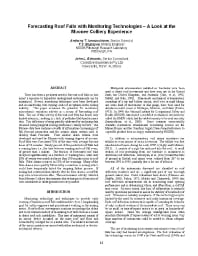Mining Publication: Forecasting Roof Falls with Monitoring Technologies - A Look at the Moonee Colliery Experience
Original creation date: August 2005
Authors: AT Iannacchione, TS Bajpayee, JL Edwards
NIOSHTIC2 Number: 20028267
In: Peng SS, Mark C, Finfinger GL, Tadolini SC, Heasley KA, Khair AW, eds. Proceedings of the 24th International Conference on Ground Control in Mining, Morgantown, West Virginia, August 2-4, 2005. Morgantown, WV: West Virginia University, 2005; :44-51
There has been a persistent need to forecast roof falls so that miner's exposure to hazardous underground environments can be minimized. Several monitoring techniques have been developed and are used today with varying levels of acceptance in the mining industry. This paper examines the potential for monitoring microseismic emissions activity as a means of forecasting roof falls. The use of this activity to forecast roof falls has drawn only limited attention, resulting in a lack of published field performance data. This deficiency is being partially addressed by analyzing data obtained during longwall mining at Moonee Colliery in 1998. The Moonee data base contains a wealth of information concerning roof fall forecast parameters and the seismic alarm criteria used to develop these forecasts. Four seismic alarm criteria were developed and used by Moonee with varying degrees of success. Roof falls were forecasted 73% of the time with average forecast times of 54 minutes. Ninety percent of the predicted roof falls had a warning time, i.e., the time between warning and roof fall event, of greater than 1 minute. The fraction of forecasted roof falls decayed logarithmically as a function of warning time, until only 20% of events were predicted more than 100 minutes prior to roof falls. False alarms occurred in 50% of the warnings. Many of the false alarms were quickly followed by a cessation in mining which could have temporarily halted the on-going failure process. If mining had continued immediately after the false alarms, a roof fall may have occurred soon after. The microseismic activity collected from Moonee Colliery demonstrates that techniques to forecast roof rock instabilities in underground mines are possible.

NIOSHTIC2 Number: 20028267
In: Peng SS, Mark C, Finfinger GL, Tadolini SC, Heasley KA, Khair AW, eds. Proceedings of the 24th International Conference on Ground Control in Mining, Morgantown, West Virginia, August 2-4, 2005. Morgantown, WV: West Virginia University, 2005; :44-51
- Characteristics of Mining-Induced Seismicity Associated with Roof Falls and Roof Caving Events
- Detecting Strata Fracturing and Roof Failures from a Borehole Based Microseismic System
- An Evaluation of Microseismic Activity Associated with Major Roof Falls in a Limestone Mine: a Case Study
- Make it Safer with Roof Screen
- Mapping Hazards with Microseismic Technology to Anticipate Roof Falls - A Case Study
- Optimizing Secondary Roof Support with the NIOSH Support Technology Optimization Program (STOP)
- Overview of Coal Mine Ground Control Issues in the Illinois Basin
- The Relationship of Roof Movement and Strata-Induced Microseismic Emissions to Roof Falls
- Roof Screening: Best Practices and Roof Bolting Machines
- Technology News 483 - Safety Training Tools for Rock Scaling Personnel